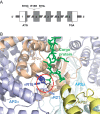Disorders of the calcium-sensing receptor and partner proteins: insights into the molecular basis of calcium homeostasis
- PMID: 27647839
- PMCID: PMC5064759
- DOI: 10.1530/JME-16-0124
Disorders of the calcium-sensing receptor and partner proteins: insights into the molecular basis of calcium homeostasis
Abstract
The extracellular calcium (Ca(2+) o)-sensing receptor (CaSR) is a family C G protein-coupled receptor, which detects alterations in Ca(2+) o concentrations and modulates parathyroid hormone secretion and urinary calcium excretion. The central role of the CaSR in Ca(2+) o homeostasis has been highlighted by the identification of mutations affecting the CASR gene on chromosome 3q21.1. Loss-of-function CASR mutations cause familial hypocalciuric hypercalcaemia (FHH), whereas gain-of-function mutations lead to autosomal dominant hypocalcaemia (ADH). However, CASR mutations are only detected in ≤70% of FHH and ADH cases, referred to as FHH type 1 and ADH type 1, respectively, and studies in other FHH and ADH kindreds have revealed these disorders to be genetically heterogeneous. Thus, loss- and gain-of-function mutations of the GNA11 gene on chromosome 19p13.3, which encodes the G-protein α-11 (Gα11) subunit, lead to FHH type 2 and ADH type 2, respectively; whilst loss-of-function mutations of AP2S1 on chromosome 19q13.3, which encodes the adaptor-related protein complex 2 sigma (AP2σ) subunit, cause FHH type 3. These studies have demonstrated Gα11 to be a key mediator of downstream CaSR signal transduction, and also revealed a role for AP2σ, which is involved in clathrin-mediated endocytosis, in CaSR signalling and trafficking. Moreover, FHH type 3 has been demonstrated to represent a more severe FHH variant that may lead to symptomatic hypercalcaemia, low bone mineral density and cognitive dysfunction. In addition, calcimimetic and calcilytic drugs, which are positive and negative CaSR allosteric modulators, respectively, have been shown to be of potential benefit for these FHH and ADH disorders.
Keywords: G protein; kidney; parathyroid and bone; signal transduction.
© 2016 Society for Endocrinology.
Figures






References
-
- Atay Z, Bereket A, Haliloglu B, Abali S, Ozdogan T, Altuncu E, Canaff L, Vilaca T, Wong BY, Cole DE, et al. 2014. Novel homozygous inactivating mutation of the calcium-sensing receptor gene (CASR) in neonatal severe hyperparathyroidism-lack of effect of cinacalcet. Bone 64 102–107. (10.1016/j.bone.2014.04.010) - DOI - PubMed
-
- Babinsky VN, Hannan FM, Gorvin CM, Howles SA, Nesbit MA, Rust N, Hanyaloglu AC, Hu J, Spiegel AM, Thakker RV. 2016. Allosteric modulation of the calcium-sensing receptor rectifies signaling abnormalities associated with G-protein alpha-11 mutations causing hypercalcemic and hypocalcemic disorders. Journal of Biological Chemistry 291 10876–10885. (10.1074/jbc.M115.696401) - DOI - PMC - PubMed
-
- Breitwieser GE, Gama L. 2001. Calcium-sensing receptor activation induces intracellular calcium oscillations. American Journal of Physiology: Cell Physiology 280 C1412–1421. - PubMed
Publication types
MeSH terms
Substances
Grants and funding
LinkOut - more resources
Full Text Sources
Other Literature Sources
Molecular Biology Databases
Miscellaneous

